 |
Back to: |
Engineer
Main Menu
Biographies &
Stories Mainpage |
"Getting it Right"
ASEE Prism Magazine
Attracting women to engineering is tough, but some
schools have found a formula
that seems to work.
March, 2001 -- BY MARGARET MANNIX
|
In
1985, women earned 15 percent of the bachelor's degrees
in engineering. Information collected by ASEE indicates
that just over 21 percent of bachelor's degrees awarded
in engineering in 1999 went to women. There are far
more women entering law, medicine, and business-fields
previously overwhelmingly dominated by men. No wonder
the commission noted that the U.S. science, engineering,
and technology workforce "is comprised mainly of white
males, with small percentages of women and minority
group members."
Yet there are plenty of women and minorities in the
general workforce, they just don't have the skills
to thrive in the new, technology-driven economy. Facing
a shortage of such workers, warns business leaders,
means the nation may not be able to remain competitive
in the global marketplace. What's so alarming, say
the report's authors, is that the U.S. "risks losing
its economic and intellectual preeminence." |
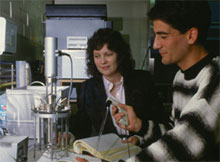
Recruiting female educators like Mary Roth, associate
professor of civil and environmental engineering at
Lafayette College, help colleges retail more women
students. |
|
That's
a heavy burden for those on the front line of higher education
to bear. Some engineering schools have excelled in upping
the ranks of women in their midst. But trying to pin down
exactly how they achieve those enviable percentages is a
science in itself. There's no magic formula and certainly
no such thing as a silver bullet. In some cases, it just
means being in the right place at the right time. In others,
it takes an aggressive recruiting effort.
Engineering schools with high numbers of female students
say the best, albeit the most obvious, way to attract female
students is to increase the number of female faculty members.
"We have quadrupled the number of female faculty in the
past six to seven years," says Ioannis Miaoulis, dean of
the Tufts University College of Engineering. "The message
is out there that women succeed at Tufts," says Mialouis,
who boasts a faculty that is 16 percent female and a school
that is 33 percent female. At the undergraduate level, the
percentages are even higher with women accounting for nearly
40 percent of the engineering graduates.
That goal is echoed by James Schaffer, director of engineering
at Lafayette College, where 31 percent of the bachelor's
degrees in engineering last year went to women. "We work
very hard to recruit and retain quality female engineering
faculty," says Schaffer.
"They serve as wonderful mentors and role models for our
women students." Janie Fouke, dean of the School of Engineering
at Michigan State University, says she and her counterparts
play a very important role. "It's very difficult to go someplace
new and scary like a new career without having someone ahead
of you to see how the path is lighted." Michigan State awarded
160 bachelor's degrees in engineering to women last year,
26 percent of the total. Trailblazers like Fouke also serve
as an inspiration to prospective and new female students.
"It's sort of a 'If they can do it, I can do it,'" says
Kay C. Dee, an assistant professor in the department
of biomedical engineering at Tulane University, where
28 percent of the bachelor's degrees in engineering
were earned by women last year. "It's an immediate,
visible confirmation that they wouldn't be out of
place. It's important to dispel the myth that if they
are going to become an engineer, they are going to
be one woman out of 300 men." "It's the willingness
to deal with students on an informal basis that is
extremely important for us," says Schaffer. Jane Daniels,
director of the women in engineering program at Purdue
University, places a particular emphasis on that task.
"I certainly do a lot of individual talking with students
so they know me, they know my face, they know how
to get a hold of me," says Daniels. "They do feel
that tie, that familiarity with people on campus."
Fouke agrees and also makes a point of spending time
with her students. "You don't have to go to every
club meeting," she says. "But it's so important just
to spend time chatting or loitering in the hallway
with students."
Providing that comfort level is key to retaining female
students, say many colleges. At Lafayette, faculty
members have formal advising duties, but Schaffer
believes it is the school's open-door policy that
really succeeds. He notes that each time he walks
past a particular female colleague's office, there
is always a student inside. |
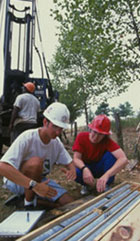 Students in the chemicalengineering department at
the University of Colorado work on new biomaterials
to repair damage in joints.
Students in the chemicalengineering department at
the University of Colorado work on new biomaterials
to repair damage in joints. |
Their Own Kind
Like money attracts money, a critical mass of female students
acts as an excellent recruiting tool. John Birge, dean of
the McCormick School of Engineering at Northwestern University,
says his school's open house activities for prospective
students and parents are heavily weighted with women students.
One recent weekend, says Birge, two out of three students
involved were female, and parents reacted positively. "Our
best p.r. is our current students," Birge says. "They are
the best salespeople we can find." Indeed, a mere glance
at the industrial engineering students at the University
of Oklahoma-51 percent of whom are women-can make an impression.
High-school girls "are more apt to say this is a friendly
place, even if only subconsciously," says Donna Shirley,
assistant dean of engineering for advanced program development
at the university.
Classes loaded with women can also aid retention rates.
"When you have small numbers of women, it's a very isolating
experience," says Jill Tietjen, director of the women in
engineering program at the University of Colorado at Boulder.
The more female students enrolled in a class, the more confident
they feel in their major and their career choice. Outside
organizations such as the Society of Women Engineers can
also foster a supportive environment by sponsoring clubs
and functions on and off campus for female students.
Some engineering schools say their strong numbers are partially
due to plain old luck-luck to be part of a university that
has no trouble attracting a diverse population. At the University
of Notre Dame, for example, the university student population
is almost evenly divided between the sexes. "I think it's
a natural evolution,"says John Uhran, associate dean of
the College of Engineering. "We have a fairly diverse university,
and I think that's attractive to a lot of women," says Northwestern's
Birge. "We also happen to have strengths in areas that I
think maybe appeal to women. Our industrial engineering
department is quite strong, and biomedical and life science."
What's more, Northwestern's engineering school has a variety
of joint programs, from music and journalism to law and
business. "A lot of these programs probably attract more
than the average percentage of women," Birge says. "The
medical one is the most popular. I bet half of the students
in that program are women."
|
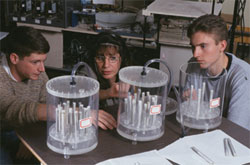
University of Notre Dame chemical engineering professor
Salma Saddawi assists students with an experimant
involving the oxidation of concrete.

Students are on their way to class at the Technological
Institute, home of Northwestern's Robert R. McCormick
School of Engineering and Applied Science. |
Hands On
Some universities are creating courses that will hook
students into engineering faster by giving them a
taste of how dynamic such a career can be-a strategy
that helps keep female students on the engineering
track. For example, a first-year engineering student
at Tufts University can enroll in mini courses on
technology that carry half the credit of a regular
course. The purpose: to relay engineering principles
with real-world examples. "They oftentimes stem out
of the personal interests and hobbies of the faculty,"
says Miaoulis. For example, a student can learn the
design and performance of musical instruments. "These
courses make engineering very exciting and bring it
closer to everyday life," says Miaoulis.
Lafayette officials say its college of engineering
benefits from an academic program that combines engineering
and liberals arts. "I think a rich liberal arts tradition
acts in our favor," says Schaffer. "All of our courses
for all of our students tend to have the social, ethical,
environmental, economic, and political issues of technology.
That's a plus for us for women students," he says,
noting that many women are attracted to the socially
responsible aspects of technology. "They want to make
medicine and clean the environment," says Schaffer.
That's not to say men don't like to do the same things.
Generally speaking, though, says Schaffer, female
students seem to embrace the added dimension that
Lafayette offers.
Universities are also finding that female students
like the trend away from the standing-lecture based
teaching system. For example, Lafayette's chemical
engineering class used to consist of three one-hour
lectures a week. Now the class meets for two one-hour
lectures plus a two-hour nontraditional session. One
week it might be a demonstration in the lab, the next
week it might be a problem-solving session done by
the class in small groups. "One of the keys to recruiting
and retaining a diverse body of students is to realize
there are a lot of ways for people to learn," says
Schaffer. "You are giving students with every learning
style a chance to gather the information they need
to be successful. Everybody is getting a little bit
of their preferred learning style."
|
Many believe that the embracing of teamwork by engineering
colleges is another factor in attracting female students."You
don't just sit in the classroom or hover over a computer,"
Shirley says. "Women like to work in teams. They like to
work with other people. When you have a team experience,
it's more satisfying." In addition, colleges stress that
diversity inspires creativity and productivity. "When you
have a team that consists of people from different backgrounds,
the design is better," says Miaoulis. The same goes for
those ubiquitous club projects dominated by men, such as
the racing or solar car clubs. Shirley wants to institutionalize
those clubs so more women will participate. "We have trouble
getting young women to go into those projects," says Shirley.
"They get a little bit intimidated. They haven't grown up
building motorcycles."
As children, girls also haven't typically dreamed of becoming
engineers either. So Shirley and her colleagues at Oklahoma
have designed a freshman seminar entitled "The 21st Century
Woman: Tomorrow's Woman in Science, Engineering, and Technology"
to address that vacuum. The course grew out of research
that revealed that women were declaring engineering as majors
but graduating in totally different fields.
"We believe a large part of it is because the kids get discouraged,"
says Shirley. Topics of discussion include career versus
family issues, sexual harassment, and job opportunities.
The class provides an awareness of the difficulties faced
by women pursuing a career in the sciences, as well as advice
on helping them cope with the pressure of being in fields
dominated by men. "We also emphasize that with engineering
you are working with people and solving problems," says
Shirley. "We at least give them a flavor of what engineering
is."
|
 Lafayette College engineering student Kenda Roberts
talks with David Veshosky, associate professor of
civil and environment engineering.
Lafayette College engineering student Kenda Roberts
talks with David Veshosky, associate professor of
civil and environment engineering.
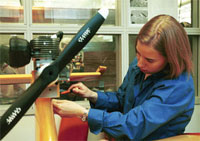 An engineering
student at the University of Colorado at Boulder
works on her aerodynamics project.
An engineering
student at the University of Colorado at Boulder
works on her aerodynamics project. |
Meeting the Parents
At Purdue, Daniels finds that those explanations
are helpful to parents of prospective female students
too. That's why parents are included in many of
the women in engineering functions. "We probably
have an equal number of parents coming as students,"
says Daniels, who assuages parents' fears that their
daughters are choosing a career that will lead to
them denying their femininity and forgoing marriage
and family. "I take the parents and meet with them
separately and take two hours and answer questions.
We spend a lot of time assuring the parents that
their daughters can have a good experience."
Daniels says she doesn't hear those same concerns
coming from parents of would-be male engineering
students. "The parents seem much more inclined if
they have a son coming to Purdue to sort of let
them do their own thing. It's a conservative state.
I don't hear those kind of questions coming from
parents of sons, because they aren't doing something
different. They are still concerned about their
little girls."
At Lafayette, Schaffer makes sure that prospective
female high-school students, who are typically sent
over to his department after speaking with an admissions
officer, chat with a female faculty member, if possible.
First, students are matched with a professor in
their desired field of study, such as mechanical
engineering. "Second will be to try to match students
up by gender or ethnic background," he says. "It
places a bit of a burden on the women who are on
our faculty," says Schaffer. "When we recruit faculty,
we ask if this is something that you like to do."
|
Introducing engineering to an even younger contingent
also seems to ratchet up the female ranks. At Purdue,
for example, high-school girls can participate in
career programs designed specifically for them. "It's
a real advantage to get them here on campus," says
Daniels. "I feel like if we can get them here we are
much more likely to get them to come back as an undergraduate
student." Last year, the school hired a director of
precollege programs for the women in engineering program.
"She is going to be starting a lot more programs for
high-school girls and young girls so we can start
working on the pool a little bit younger," says Daniels.
Some experts believe that lesson should be taught
to all ages. "In the U.S., a lot of people don't even
know what engineers do," says Gail Mattson, president
of the Society of Women Engineers. Or they think of
engineers as these Dilbert-like drones confined to
cubicles, void of passion and creativity. A lot of
educators are really concerned about the image of
engineering, particularly when it comes to attracting
women to the field. "We have been as high as 27 to
28 percent and that has definitely been dropping,"
says Notre Dame's Uhran, who notes the current rate
is about 22 percent. "We have been wondering why this
is happening." That's the million-dollar question
these days. |
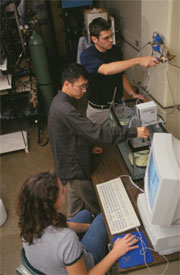 University of Notre Dame chemical engineering seniors
monitor a bioreactor that they built themselves.
Many educators believe that working in teams is
satisfying to students of both sexes.
University of Notre Dame chemical engineering seniors
monitor a bioreactor that they built themselves.
Many educators believe that working in teams is
satisfying to students of both sexes. |
Margaret
Mannix is a freelance writer living in suburban Washington,
D.C.
© Reprinted with permission from ASEE Prism Magazine
|
|
|
|
|



